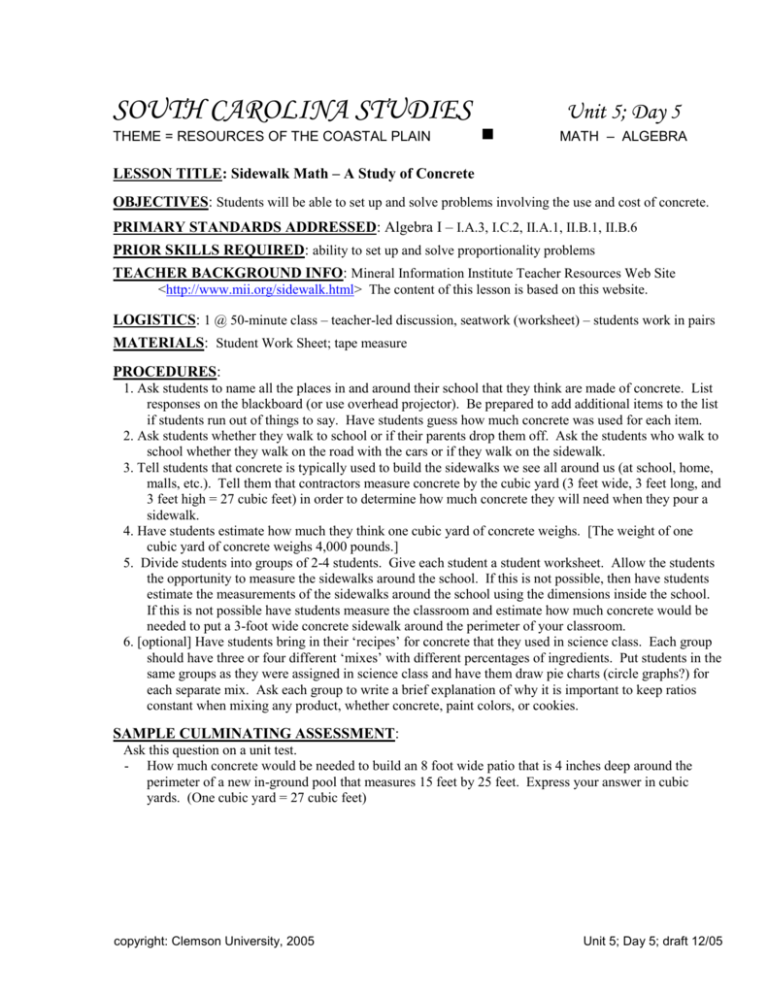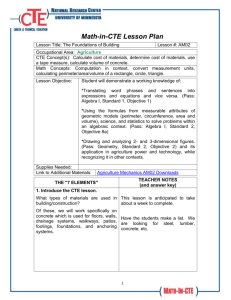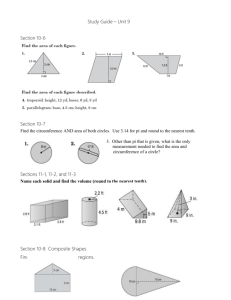A Study of Concrete - Clemson University
advertisement

SOUTH CAROLINA STUDIES THEME = RESOURCES OF THE COASTAL PLAIN Unit 5; Day 5 MATH – ALGEBRA LESSON TITLE: Sidewalk Math – A Study of Concrete OBJECTIVES: Students will be able to set up and solve problems involving the use and cost of concrete. PRIMARY STANDARDS ADDRESSED: Algebra I – I.A.3, I.C.2, II.A.1, II.B.1, II.B.6 PRIOR SKILLS REQUIRED: ability to set up and solve proportionality problems TEACHER BACKGROUND INFO: Mineral Information Institute Teacher Resources Web Site <http://www.mii.org/sidewalk.html> The content of this lesson is based on this website. LOGISTICS: 1 @ 50-minute class – teacher-led discussion, seatwork (worksheet) – students work in pairs MATERIALS: Student Work Sheet; tape measure PROCEDURES: 1. Ask students to name all the places in and around their school that they think are made of concrete. List responses on the blackboard (or use overhead projector). Be prepared to add additional items to the list if students run out of things to say. Have students guess how much concrete was used for each item. 2. Ask students whether they walk to school or if their parents drop them off. Ask the students who walk to school whether they walk on the road with the cars or if they walk on the sidewalk. 3. Tell students that concrete is typically used to build the sidewalks we see all around us (at school, home, malls, etc.). Tell them that contractors measure concrete by the cubic yard (3 feet wide, 3 feet long, and 3 feet high = 27 cubic feet) in order to determine how much concrete they will need when they pour a sidewalk. 4. Have students estimate how much they think one cubic yard of concrete weighs. [The weight of one cubic yard of concrete weighs 4,000 pounds.] 5. Divide students into groups of 2-4 students. Give each student a student worksheet. Allow the students the opportunity to measure the sidewalks around the school. If this is not possible, then have students estimate the measurements of the sidewalks around the school using the dimensions inside the school. If this is not possible have students measure the classroom and estimate how much concrete would be needed to put a 3-foot wide concrete sidewalk around the perimeter of your classroom. 6. [optional] Have students bring in their ‘recipes’ for concrete that they used in science class. Each group should have three or four different ‘mixes’ with different percentages of ingredients. Put students in the same groups as they were assigned in science class and have them draw pie charts (circle graphs?) for each separate mix. Ask each group to write a brief explanation of why it is important to keep ratios constant when mixing any product, whether concrete, paint colors, or cookies. SAMPLE CULMINATING ASSESSMENT: Ask this question on a unit test. - How much concrete would be needed to build an 8 foot wide patio that is 4 inches deep around the perimeter of a new in-ground pool that measures 15 feet by 25 feet. Express your answer in cubic yards. (One cubic yard = 27 cubic feet) copyright: Clemson University, 2005 Unit 5; Day 5; draft 12/05 SOUTH CAROLINA STUDIES THEME = RESOURCES OF THE COASTAL PLAIN Unit 5; Day 5 MATH – ALGEBRA STUDENT WORK SHEET LESSON TITLE: Sidewalk Math – A Study of Concrete Concrete is measured by the cubic yard (3 feet wide, 3 feet long, and 3 feet high, or 27 cubic feet). One cubic yard of concrete weighs approximately 4000 pounds. 1. How many cubic yards of concrete are in the sidewalks around your school? (Concrete in sidewalks is generally about 4 inches thick) a. Total length of sidewalks around school: ___________________________ b. Width of sidewalks around school: ________________________________ c. Number of cubic yards of concrete in the sidewalks around your school? _____________________________________________________________ d. How much does the entire sidewalk system around your school weigh? _____________________________________________________________ 2. Represent the total number of cubic yards of concrete needed to build a sidewalk 4 feet wide and 4 inches thick for a length of l feet, as a function, T(l). _________________________________________________________________________________ 3. How many cubic yards of concrete are needed to place a floor in a two car garage (normally 20 feet by 20 feet by 4 inches thick)? _________________________________________________________________________________ 4. How many cubic yards of concrete would be needed if the floor in your classroom was made entirely of concrete? (Assume the floor would be 4 inches thick.) _________________________________________________________________________________ 5. If concrete costs $75 per cubic yard (delivered), how much would the following cost: a. Sidewalk around your school: __________________________________________________ b. Floor of two car garage: ______________________________________________________ c. Floor in your classroom: ______________________________________________________ 6. If concrete costs $75 per cubic yard, represent the total cost, C, of a particular project as a function, C(x), where x represents the number of cubic yards for the project. _________________________________________________________________________________ 7. Consider the graph of the function C(x) (form #6) in the xy-plane. If the cost of concrete was raised from $75 per cubic yard to $90 per cubic yard and the function was adjusted to account for this shift in price. How would the graph of the new C(x) compare to the original graph? _____________________________________________________________________________________ _____________________________________________________________________________ copyright: Clemson University, 2005 Unit 5; Day 5; draft 12/05 SOUTH CAROLINA STUDIES THEME = RESOURCES OF THE COASTAL PLAIN Unit 5; Day 5 MATH – ALGEBRA TEACHER ANSWER KEY LESSON TITLE: Sidewalk Math – A Study of Concrete 1. Ask students to name all the places in and around their school that they think are made of concrete . . . . Student answers may vary depending on the age of their school and its method of construction. But virtually all schools will have sidewalks made of concrete and these provide good areas for students to get out and measure to collect raw data for their calculations. 2. Ask students whether they walk to school or if their parents drop them off. Ask the students who walk to school whether they walk on the road with the cars or if they walk on the sidewalk. Some students will walk to school or at least have some type of experience walking on a concrete sidewalk. Ask students to consider the sidewalk around your school. 3. Tell students that concrete is typically used to build the sidewalks we see all around . . . . Students should be consistent when making calculations. If students are using feet for their measurements below, then they should be consistent with each measurement. For example if students measure in feet, then they should convert 4 inches into feet (1/3 foot) before calculation the total number of cubic feet. Once this value is calculated, then students can compute the total number of cubic yards by dividing by 27. 4. Have students estimate how much they think one cubic yard of concrete weighs. [The weight of one cubic yard of concrete weighs approximately 4,000 pounds.] Students will likely underestimate the weight because they tend to see the cubic shape as an empty box rather than solid. In case you want to show students the calculation, tell them that most rock (including concrete) has a density between 2.4 and 2.8 times denser than water. The density of water is 62.5 pounds per cubic foot, and the density of concrete is about 150 pounds per cubic foot. Because there are 27 cubic feet in 1 cubic yard, you must multiply 150 pounds by 27 to get 4,050 pounds per cubic yard (approximately 4,000 pounds per cubic yard).. 5. Divide students into groups of 2-4 students. Give each student a student worksheet . . . . It may be helpful to divide the area around your school into different parts so that each group of students is not measuring the entire length of the sidewalks surrounding your school. Have each group of students measure a certain area (north, south, east, west side) of the school. Combine the findings of the students before allowing them to calculate their answers to the questions on the student worksheet. If it is not possible to have your students actually measure the lengths, then you can provide the value for them either from your own measurements or an estimation. ANSWERS FOR USE WITH STUDENT WORKSHEET The answers given below follow an assumption that the length of the sidewalks around your school are 600 feet. Also assume the dimensions of your classroom are 20 feet wide and 30 feet long. Actual answers will vary depending on the specific values measured at your own school. 1. How many cubic yards of concrete are in the sidewalk around your school? (Sidewalks are generally 4 inches thick) a. Total length of sidewalks around school: _600 feet____________________ b. Width of sidewalks around school: __3 feet _________________________ c. Number of cubic yards of concrete in the sidewalk around your school? _600 x 3 x (1/3) = 600 cubic feet = (600/27) cubic yards = 22.22 cubic yards____ d. How much does the entire sidewalk around your school weigh? _22.22 x 4000 = 88, 888.9 pounds __________________________________ copyright: Clemson University, 2005 Unit 5; Day 5; draft 12/05 2. Represent the total number of cubic yards of concrete needed to build a sidewalk 4 feet wide and 4 inches thick for a length of l feet, as a function, T(l). _T(l) = 4 x (1/3) x l = (4/3) l_____________________________________________ 3. How many cubic yards of concrete are needed to place a floor in a two car garage (normally 20 feet by 20 feet by 4 inches thick)? _20 x 20 x (1/3) = 133.33 cubic feet = (133.33/27) cubic yards = 4.94 cubic yards__ 4. How many cubic yards of concrete would be needed if the floor in your classroom was made entirely of concrete? (Assume the floor would be 4 inches thick.) _20 x 30 x (1/3) = 200 cubic feet = (200/27) cubic yards = 7.41 cubic yards_______ 5. If concrete costs $75 per cubic yard (delivered), how much would the following cost: e. Sidewalk around your school: f. Floor of two car garage: g. Floor in your classroom: 22.22 x 75 = $1666.50 . 4.94 x 75 = $370.50 ______________ 7.41 x 75 = $555.75_ ____________ 6. If concrete costs $75 per cubic yard, represent the total cost, C, of a particular project as a function, C(x), where x represents the number of cubic yards for the project. ___C(x) = 75x . 7. Consider the graph of the function C(x) (form #6) in the xy-plane. If the cost of concrete was raised from $75 per cubic yard to $90 per cubic yard and the function was adjusted to account for this shift in price. How would the graph of the new C(x) compare to the original graph? The new function would be C(x) = 90x. The graph of this new function would be steeper than the graph of the previous function (C(x) = 75x). This is because the slope of the line is larger now (90 versus 75). 6. [optional] Have students bring in their ‘recipes’ for concrete that they used in science class . . . . Actual ‘recipe’ percentages will vary depending on what the students did in science class. In all cases, these percentages can be expressed easily as pie charts (circle graphs). This activity is a good opportunity to reinforce the concepts behind constructing these types of graphs. Ratios must be kept constant if we wish to have a standard, predictable, product. SAMPLE CULMINATING ASSESSMENT: - How much concrete would be needed to build an 8 foot wide patio that is 4 inches deep around the perimeter of a new in-ground pool that measures 15 feet by 25 feet. Express your answer in cubic yards. Encourage students to draw a picture. The dimensions of the entire area are 31 by 41 (15 + 16 by 25 + 16). This yields a total are of 1271 square feet. Subtract the area of the pool itself, which is 375 square feet, to obtain the area of the concrete, which is 896 square feet. Then, multiply by 4 inches (1/3 foot) to obtain the total number of cubic feet, and then divide by 27 to determine the total number of cubic yards. 896 square feet x (1/3) foot = 298.67 cubic feet = 298.67/27 cubic yards = 11.06 cubic yards copyright: Clemson University, 2005 Unit 5; Day 5; draft 12/05







